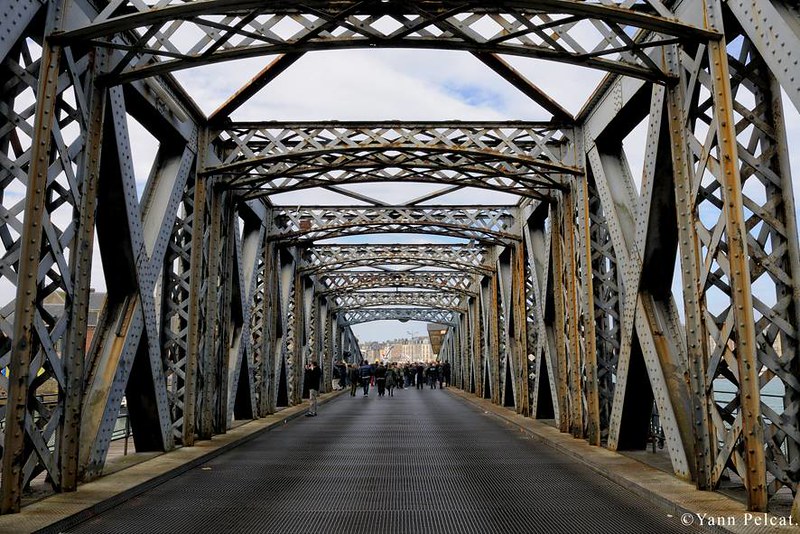Europa Nostra and EIB Institute mission visits Colbert Bridge in Dieppe, France
Heritage and financial experts from Europa Nostra and the European Investment Bank Institute visited Colbert Swing Bridge in Dieppe, France, listed among ‘The 7 Most Endangered’ heritage sites in Europe in 2016, from 31 May to 2 June. The European delegation, who was accompanied by the President of Dieppe’s Colbert Bridge Protection Committee, met with local and regional stakeholders to discuss an action plan to save and enhance the last large swing bridge still operating in Europe with its original hydraulic mechanism, dating from 1889. The key findings and recommendations of the expert mission to the site will be presented by the end of the year.
 Contemporaneous with the Eiffel Tower and using the same building techniques and materials (puddled iron), the Colbert Bridge is the only link between Dieppe’s historic centre and the harbour neighbourhood of Le Pollet. Every day, it swings 6 to 8 times for the harbour traffic and is crossed by 12,000 vehicles and 1,800 pedestrians. Despite its high reliability, the Syndicat Mixte du Port de Dieppe (SMPD), which owns the bridge, is planning to demolish it and replace it with a new structure in 2017.
Contemporaneous with the Eiffel Tower and using the same building techniques and materials (puddled iron), the Colbert Bridge is the only link between Dieppe’s historic centre and the harbour neighbourhood of Le Pollet. Every day, it swings 6 to 8 times for the harbour traffic and is crossed by 12,000 vehicles and 1,800 pedestrians. Despite its high reliability, the Syndicat Mixte du Port de Dieppe (SMPD), which owns the bridge, is planning to demolish it and replace it with a new structure in 2017.
The European delegation was comprised of Etienne Poncelet, Member of the Scientific Council of Europa Nostra, Laurent Lévi-Strauss, Member of the Council of Europa Nostra, and Campbell Thomson, Techno-economic Consultant provided by the European Investment Bank Institute. JB Cremnitzer, Architect and expert in industrial heritage, and Philippe Brouard, specialist in mechanics and automatization, joined the delegation. Pascal Stefani, President of Dieppe’s Colbert Bridge Protection Committee, which submitted the nomination for ‘The 7 Most Endangered’ programme 2016 together with the Foundation du Patrimoine, was also in attendance.
During this three-day mission, the experts had meetings with Sébastien Jumel, Mayor of Dieppe, who reaffirmed his support for the listing of the bridge as an Historic Monument, Marie-Dominique Fouchault, Director of SMPD, Jean-Christophe Lemaire, Vice-President of SMPD, Mr Derrien, SMPD, and Mrs Le Guillou, Region of Normandy. The delegation was given a guided tour through the entire harbour infrastructure, visit the Colbert Bridge and talk with the bridge operators and maintenance staff, who ensure its daily effective functioning. The experts could visit the centralised control room and thus gain a proper understanding of the issues related to the modernisation and integration of Dieppe’s harbour into the PNA network.
Later at the French Senate, the team met with Senator Catherine Morin-Desaillywho actively supports the listing proposal recommended by Europa Nostra’s experts. The European delegation welcomed the positive position of the Normandy Regional Directorate of Cultural Affairs (DRAC) regarding the protection of the Colbert Bridge.
“The Colbert Bridge is the largest swing bridge still operating in Europe with its original mechanism. Its equipments, fully hydraulic, are of a great elegance and simplicity. Apart from the replacement of the steam pumps with electrical pumps in the 20s, the entire mechanism from 1889 is still intact and has been preserved, as well as the bridge itself, almost all its authenticity and integrity. The functioning of the bridge is thus part of an uninterrupted continuity since the end of the 19th century, with the required knowledge, traditions and know-how being handed down from generation to generation by the bridge operators, creating also a rich intangible heritage which needs to be retrieved and preserved,” stated Laurent Lévi-Strauss, Member of the Council of Europa Nostra.
“Colbert Swing Bridge in Dieppe is a unique industrial heritage site not only for France but also for Europe, which absolutely needs to be preserved and to benefit from the protection granted to Historic Monuments. The desires of modernisation and automatisation of the bridge expressed by the Syndicat Mixte du Port de Dieppe are fully understandable and perfectly compatible with its classification as an Historic Monument. This will in no way prevent from modernising, securing and automating the bridge, while preserving its original mechanisms and operating principles, as it has been repeatedly proved with the successful adaptation of Historic Monuments to new needs and constraints,” stressed Etienne Poncelet, Member of the Scientific Council of Europa Nostra.
“The economic rationale for replacing the Pont Colbert is not clear. When a merchant vessel passes, it typically requires the bridge to be open for twenty minutes; a new bridge would save one or possibly two minutes out of that time. The reliability of Pont Colbert’s technology is not in question and an independent analysis has shown that the bridge is still structurally sound – despite the paintwork being neglected for many years. The current bridge meets the needs of the two communities it was meant to serve: the people of the town, and the economically active users of the port. The needs of the port operator may be changing, but the existing bridge can meet these needs, if not the port management’s desires, through the application of current expertise and technology,” noted Campbell Thomson, Techno-economic Consultant provided by the European Investment Bank Institute.
“It is now certain that the Colbert Bridge can indeed be preserved while being modernised. From now on, the aim is to find the technical and financial solution in cooperation with the SMPD,” concluded Pascal Stefani, President of the Dieppe’s Colbert Bridge Protection Committee.






